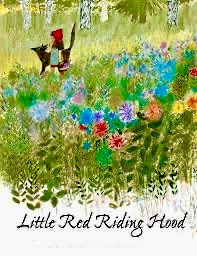BE IT RESOLVED: Little Red Riding Hood is a sexual myth.
FOR THE GOVERNMENT
Monologue:
Ladies and gentlemen, we are asked to consider a story that has been told and retold for centuries, stripped down into a child’s cautionary fable—but which, when examined honestly, reveals itself to be nothing less than a sexual myth.
Let us start with the symbols. A young girl—naïve, innocent, uninitiated—wanders into the forest, the archetypal place of danger and temptation. She wears red, the color of blood, of passion, of menstruation. Her “hood” is a signal of burgeoning womanhood, her sexual identity emerging. She leaves the safety of the village for the uncertainty of the woods, a journey not unlike the passage from childhood into sexual maturity.
Then comes the wolf. He is no mere animal. He is a figure of predatory male sexuality: charming, cunning, manipulative. He does not simply attack; he seduces through conversation, persuading her to stray from the path. In some versions, he instructs her to undress, to climb into bed. In others, he devours her whole—an act that scholars have long read as symbolic rape. The grandmother, too, is swallowed, as if to sweep aside the protective matronly figure who might guard the girl’s chastity.
The bed, that central object, is not incidental. Where does Red find the wolf disguised as her grandmother? Tucked under the covers, waiting. “What big eyes you have… what big teeth you have…” The language itself is sensual, teasing, a gradual recognition of danger wrapped in the intimacy of a bedroom scene.
Now consider the outcome. In the bowdlerized Victorian version, a huntsman rescues her—patriarchy rushing in to restore order. But in earlier tellings, there is no rescue. The girl is devoured. The story is a warning to young women: stray from the prescribed path, explore your sexuality, and you will be consumed. It is, in effect, a myth that enshrines male fear of female sexual awakening and simultaneously justifies control over it.
So, when we strip away the nursery varnish, what remains is a tale not about wolves and baskets, but about sex, desire, danger, and control. Little Red Riding Hood is a sexual myth—one that dramatizes the perils of female sexuality under a patriarchal gaze and dresses it up in the trappings of folklore.
FOR THE OPPOSITION
Monologue (Opposition):
Ladies and gentlemen, let us be clear at the outset: the attempt to reduce Little Red Riding Hood to a sexual myth is a projection—a reading imposed by modern scholars, not an inherent truth of the tale itself.
This story, in its earliest forms, was told in peasant cottages, by firelight, to warn children of the real dangers of wandering alone. The forest is not a Freudian playground but a literal one—dark, trackless, and full of predators. The wolf is not a leering seducer but a wolf, a very real and present threat to livestock and people in pre-industrial Europe.
The color red? It is tempting to weave grand theories about blood and menstruation. But more likely, it is nothing more than a memorable detail, a bright symbol to catch the imagination, the way an orange pumpkin becomes a carriage in Cinderella. We must resist the urge to retrofit folklore with psychoanalysis.
And the bed scene—so often exploited by commentators hungry for innuendo—serves a straightforward narrative purpose: tension, surprise, revelation. “What big eyes you have!” is not erotic banter but a child’s dawning recognition that she has been deceived. To children, it is a riddle of appearances, not an allegory of sex.
As for endings: yes, in some tellings she is devoured. In others, she is rescued. But both outcomes serve the same purpose—a cautionary tale. Do not stray from the path. Do not talk to strangers. Do not disobey your mother. The lesson is social, moral, practical—not sexual.
To call this tale a sexual myth is, in truth, to distort it. It ignores the historical context in which wolves were tangible threats, and it elevates symbols that may mean nothing beyond narrative color. Little Red Riding Hood is, and always has been, a child’s cautionary fable—about obedience, about vigilance, and about survival.
To impose sexual meaning upon it is to see through a glass not darkly but obsessively, replacing the story’s practical wisdom with unnecessary provocation
Adjudicator’s Decision:
Both sides have presented compelling cases.
The Government has argued that Little Red Riding Hood is a sexual myth, pointing to the symbolic freight of the red hood, the wolf as a figure of predatory male sexuality, and the intimate setting of the bed as evidence of a tale that encodes sexual danger and patriarchal control. This case is vivid, imaginative, and draws effectively on psychoanalytic and feminist readings of folklore. It gives the story cultural weight and offers a satisfying explanation for its endurance beyond mere children’s entertainment.
The Opposition, however, has argued that this interpretation is anachronistic—that to treat the wolf as a seducer is to impose modern theoretical frameworks onto a simple cautionary tale. They have stressed the historical reality of wolves, the straightforward moral lesson about obedience and vigilance, and the dangers of over-interpretation. Their argument appeals to common sense and to the story’s original context as oral folklore for rural children.
The question before us is not which interpretation is most entertaining, but which is most persuasive as an explanation of the tale’s core meaning. Here, I find that the Government carries the debate. Why? Because folklore, by its very nature, operates in layers. The Opposition is right that wolves were real dangers—but real wolves do not wear disguises, ask little girls to undress, or climb into bed. The symbolic elements outweigh the literal, and once acknowledged, they beg for a deeper interpretation. The Government provides that interpretation, framing the tale as a sexual myth that codifies anxieties about female innocence and male predation.
Therefore, I award the debate to the Government. Hal
Editorial Note: Yes, it is all created by Artificial Intelligence.
